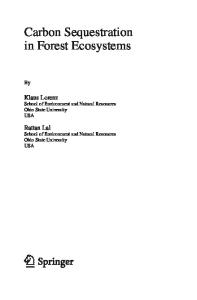Carbon Sequestration in Agricultural Soils A Multidisciplinary Appro
This compilation of techniques, methodologies and scientific data arises from a four-year Italian research project, which took place at university research stations in Turin, Piacenza, Naples and Potenza. Soil Organic Matter (SOM) represents an active and
- PDF / 7,193,324 Bytes
- 316 Pages / 439.37 x 666.142 pts Page_size
- 39 Downloads / 292 Views
.
Alessandro Piccolo Editor
Carbon Sequestration in Agricultural Soils A Multidisciplinary Approach to Innovative Methods
Editor Prof. Dr. Alessandro Piccolo Universita di Napoli Federico II Ordinario di Chimica Agraria Via Universita` 100 80055 Portici Italy [email protected]
ISBN 978-3-642-23384-5 e-ISBN 978-3-642-23385-2 DOI 10.1007/978-3-642-23385-2 Springer Heidelberg Dordrecht London New York Library of Congress Control Number: 2011943755 # Springer-Verlag Berlin Heidelberg 2012 This work is subject to copyright. All rights are reserved, whether the whole or part of the material is concerned, specifically the rights of translation, reprinting, reuse of illustrations, recitation, broadcasting, reproduction on microfilm or in any other way, and storage in data banks. Duplication of this publication or parts thereof is permitted only under the provisions of the German Copyright Law of September 9, 1965, in its current version, and permission for use must always be obtained from Springer. Violations are liable to prosecution under the German Copyright Law. The use of general descriptive names, registered names, trademarks, etc. in this publication does not imply, even in the absence of a specific statement, that such names are exempt from the relevant protective laws and regulations and therefore free for general use. Printed on acid-free paper Springer is part of Springer Science+Business Media (www.springer.com)
Preface
As part of the international quest to reduce greenhouse gas emissions into the atmosphere and on recommendation of the Kyoto Protocol, this book highlights alternatives to current soil management practices for turning agricultural soils into sinks of organic carbon. While common agronomic practices are based on traditional knowledge of soil transformation processes, this book indicates that modern or progressive understanding of complex biological systems in the soil ecosystem may already be exploited to devise new soil management practices. Explored in this book is the recent paradigmatic change in the chemical understanding of soil humus which has prompted new mechanisms for the control of soil organic matter stability. These mechanisms may be significantly more efficient at sequestering carbon in soil than current agronomic practices. The body of this book reports findings of two methods for soil carbon sequestration related to their application in agricultural field trials. These methods are definitively based on the innovative understanding of soil organic matter chemistry as supramolecular association of small molecules (1) the protection from mineralization of labile soil molecules by the hydrophobic domains present in humified mature compost amended to soils, (2) the in situ oxidative photopolymerization of soil organic matter molecules after soil spreading with a biomimetic water-soluble iron–porphyrin catalyst. The first method, although innovative in its mechanistic application, may be well considered within the current accepted soil management practices which make
Data Loading...











